Applying information technology in vocabulary teaching and learning for the first-year English non-major students at Thuong Mai University
With the development of new technologies, such as Web pages, Apps or social
network, the language learning environment seems to be more diverse and interesting.
The aim of this paper is to explore the use of Microsoft PowerPoint in a Thuong Mai
classroom to help students’ English vocabulary acquisition. In the experimental group, the
instructor used Microsoft PowerPoint lessons to teach English vocabulary while the
instructor used the traditional semantic-map method to teach English vocabulary in the
control group. The results showed that at the end of the semester, students who received
the Microsoft PowerPoint vocabulary teaching instruction performed better on the post-test.
Also, the survey found out that students agreed on using technologies in the classroom
can help language learning. That is, using Microsoft PowerPoint in language teaching can
not only enhances students’ learning outcomes, but also increases students’ learning
motivation.
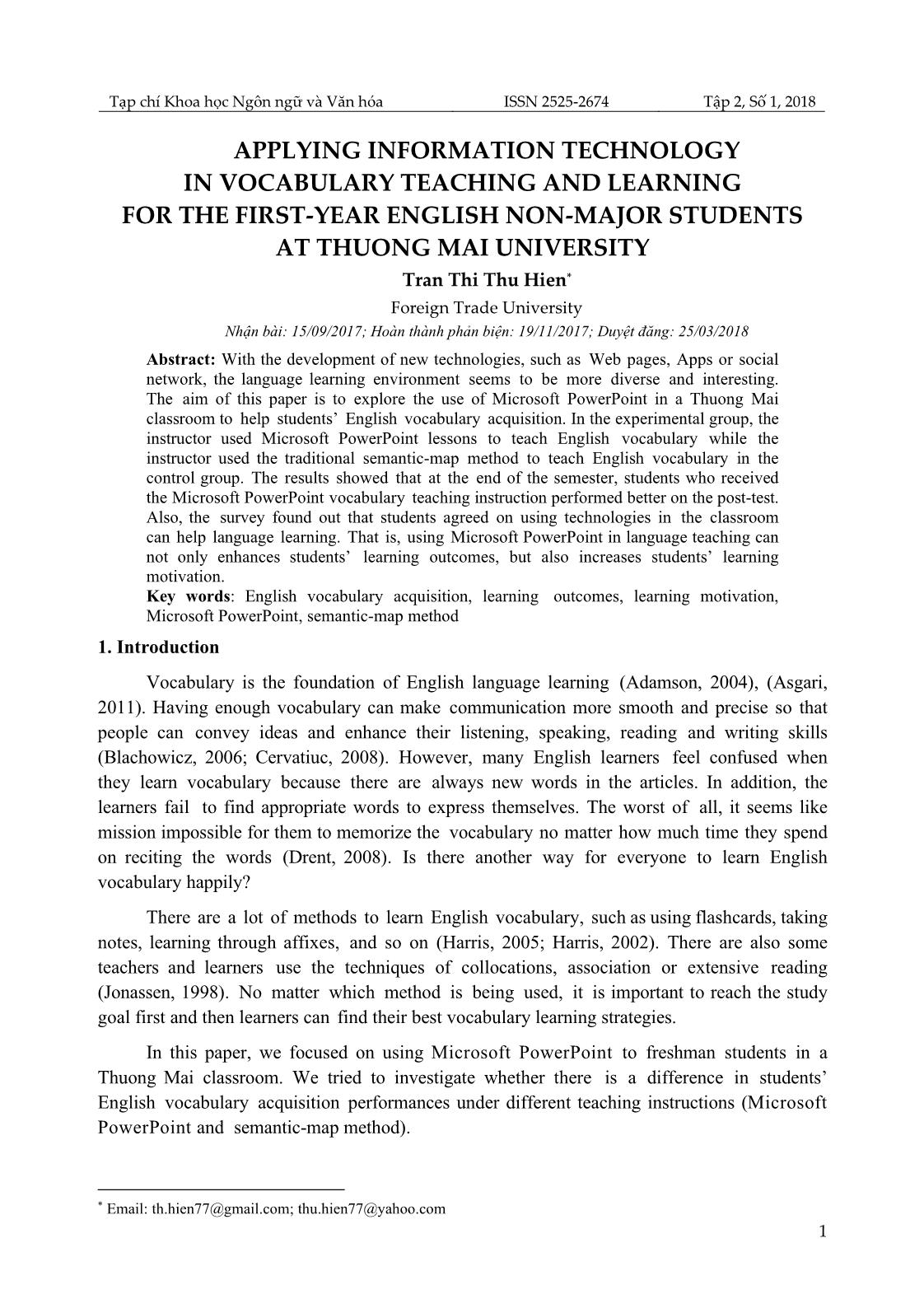
Trang 1
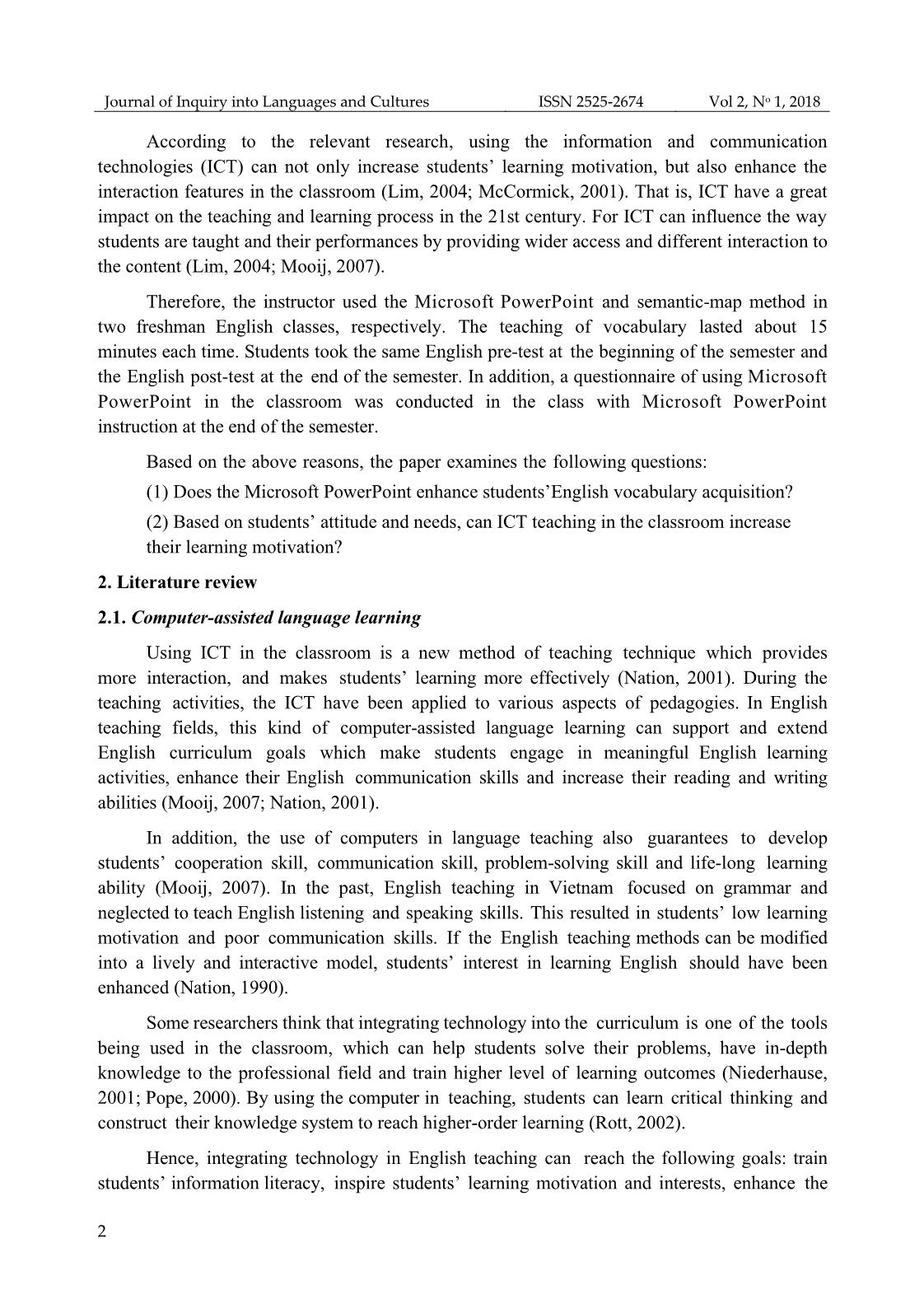
Trang 2
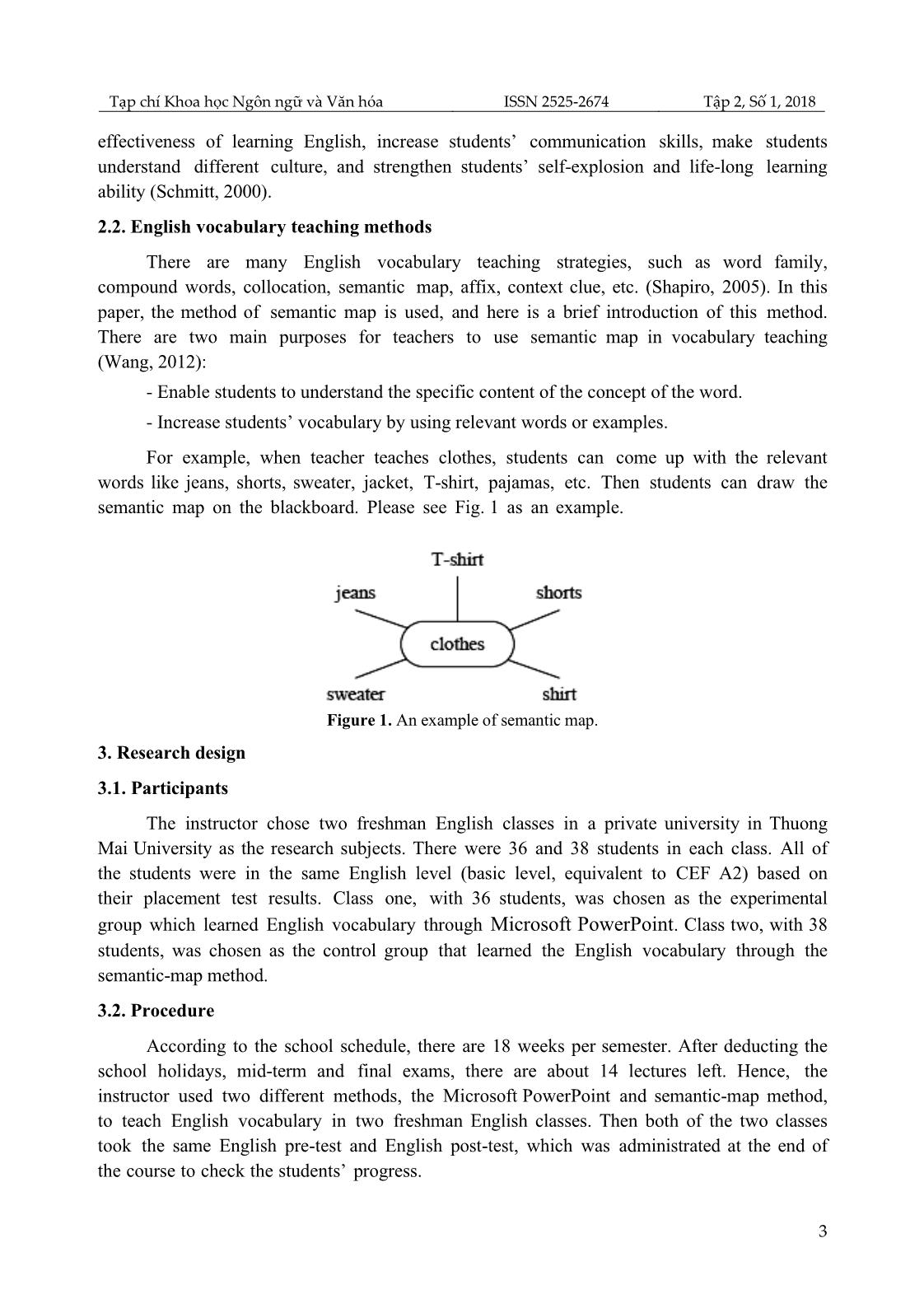
Trang 3
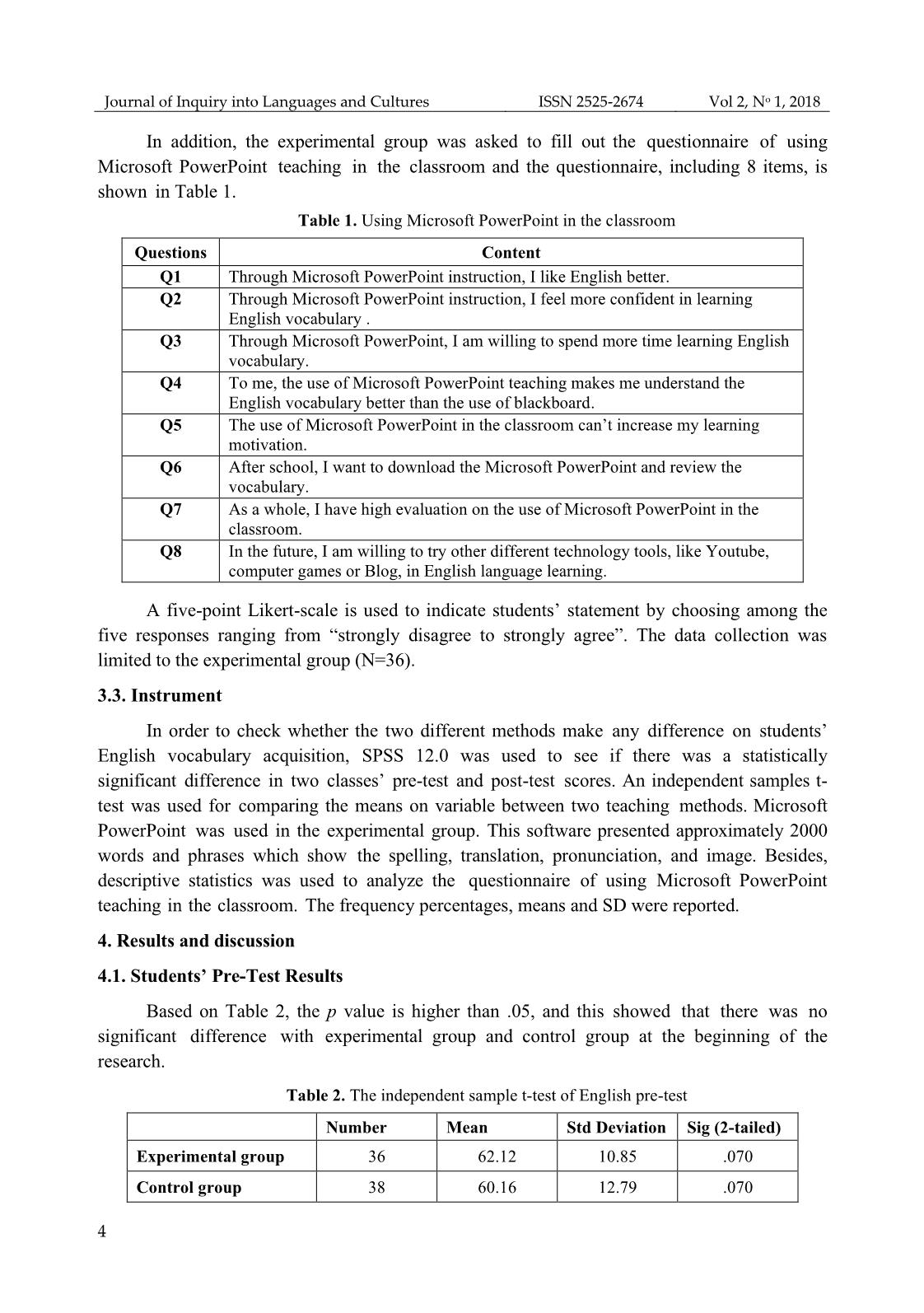
Trang 4
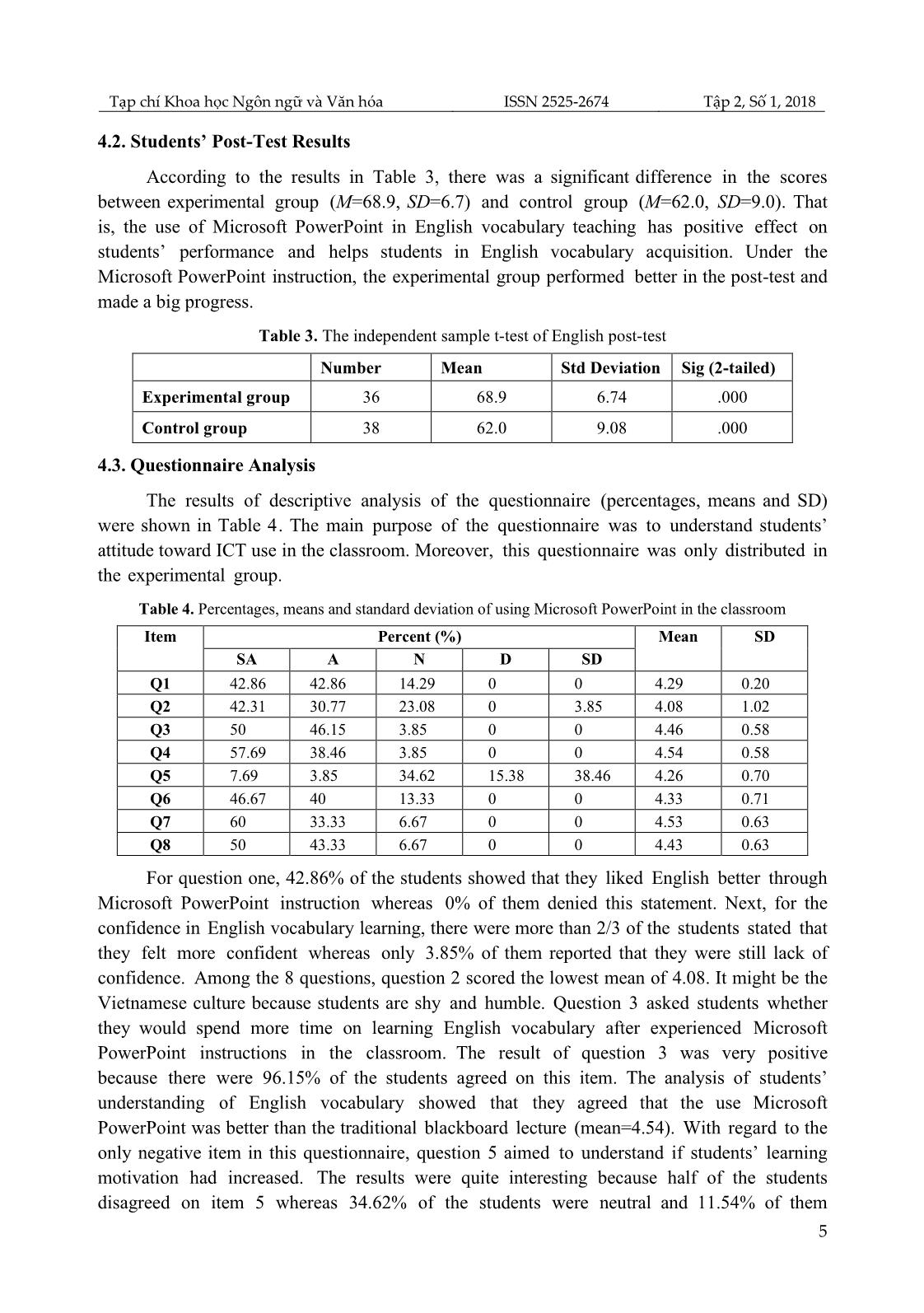
Trang 5
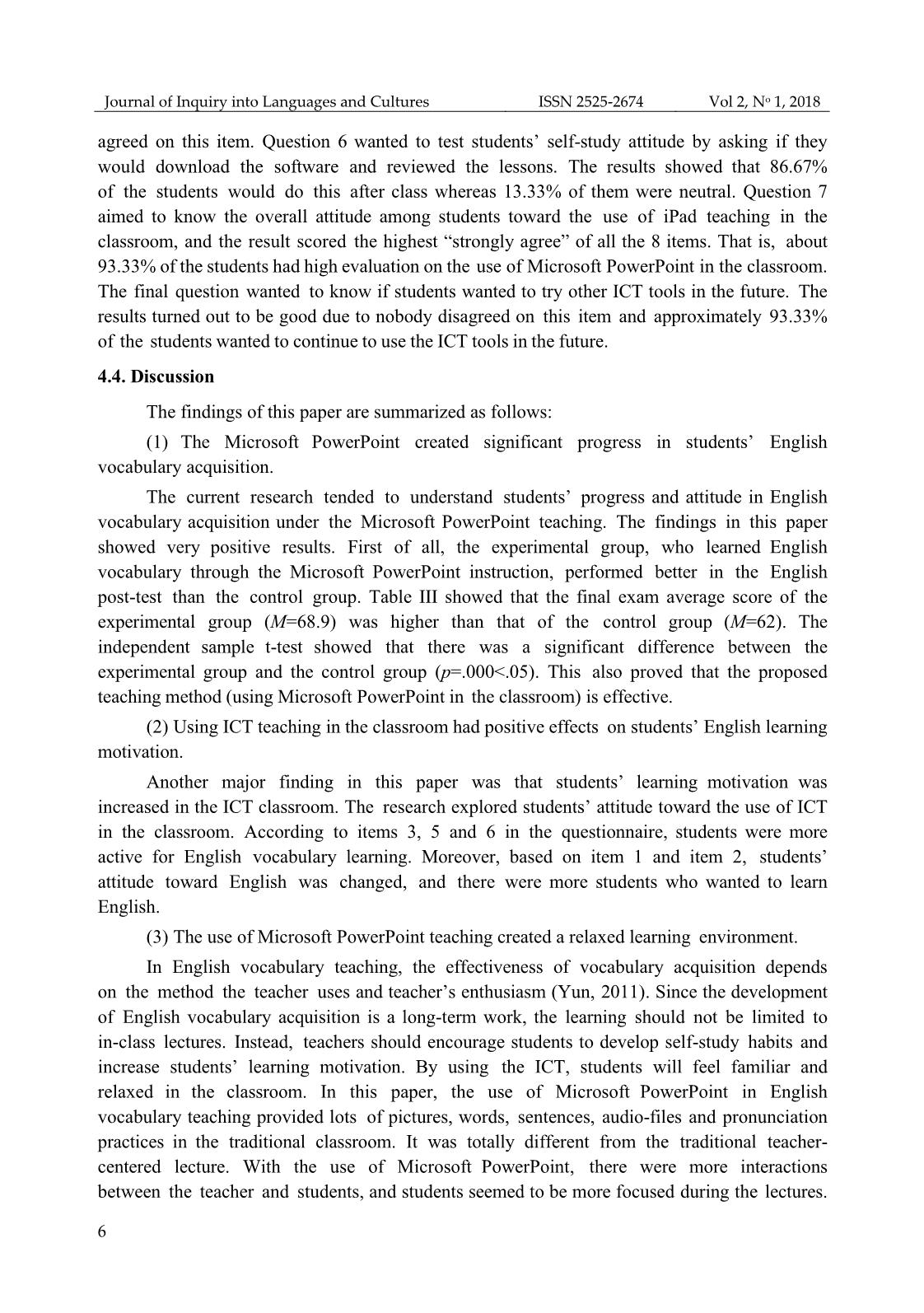
Trang 6
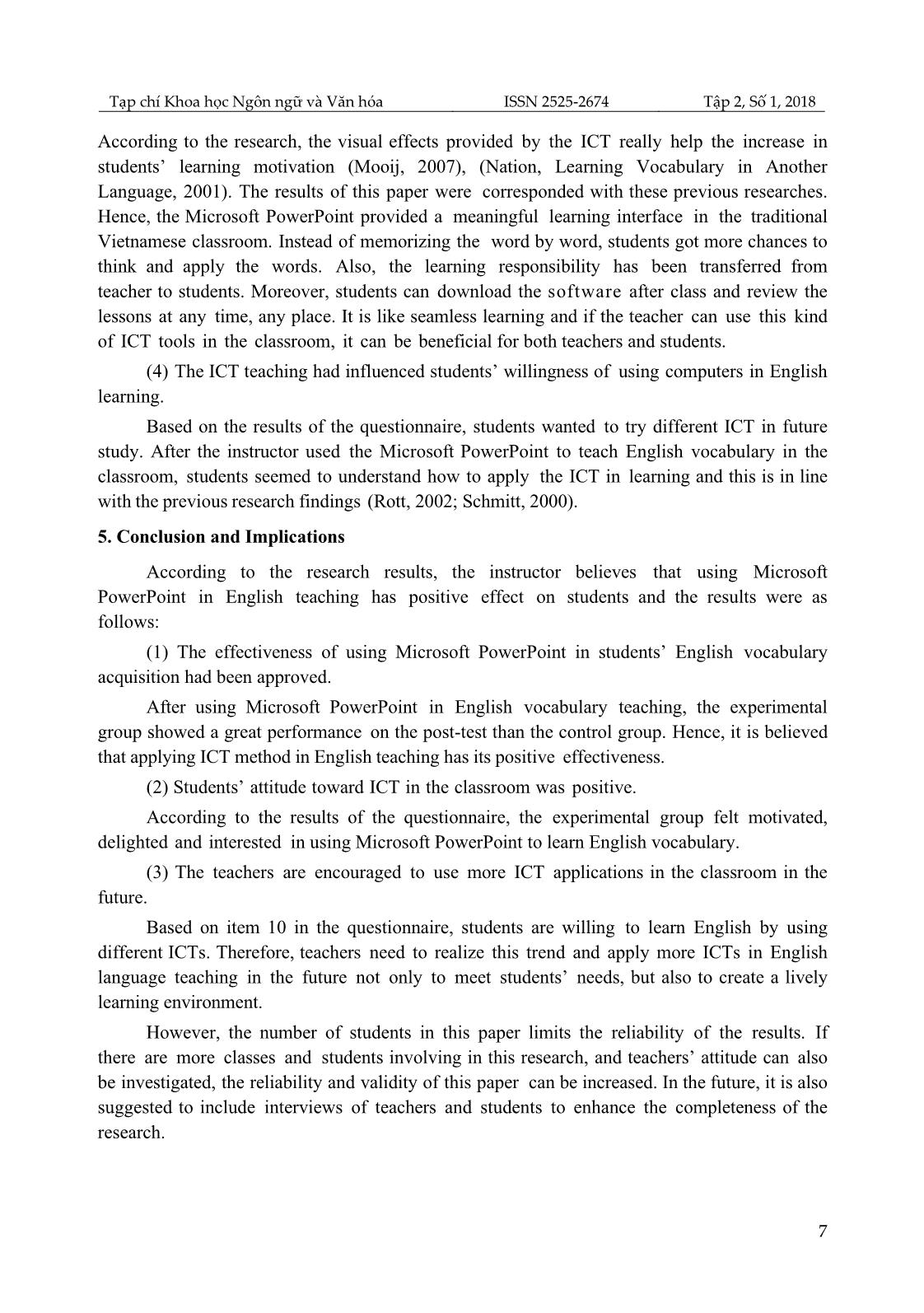
Trang 7
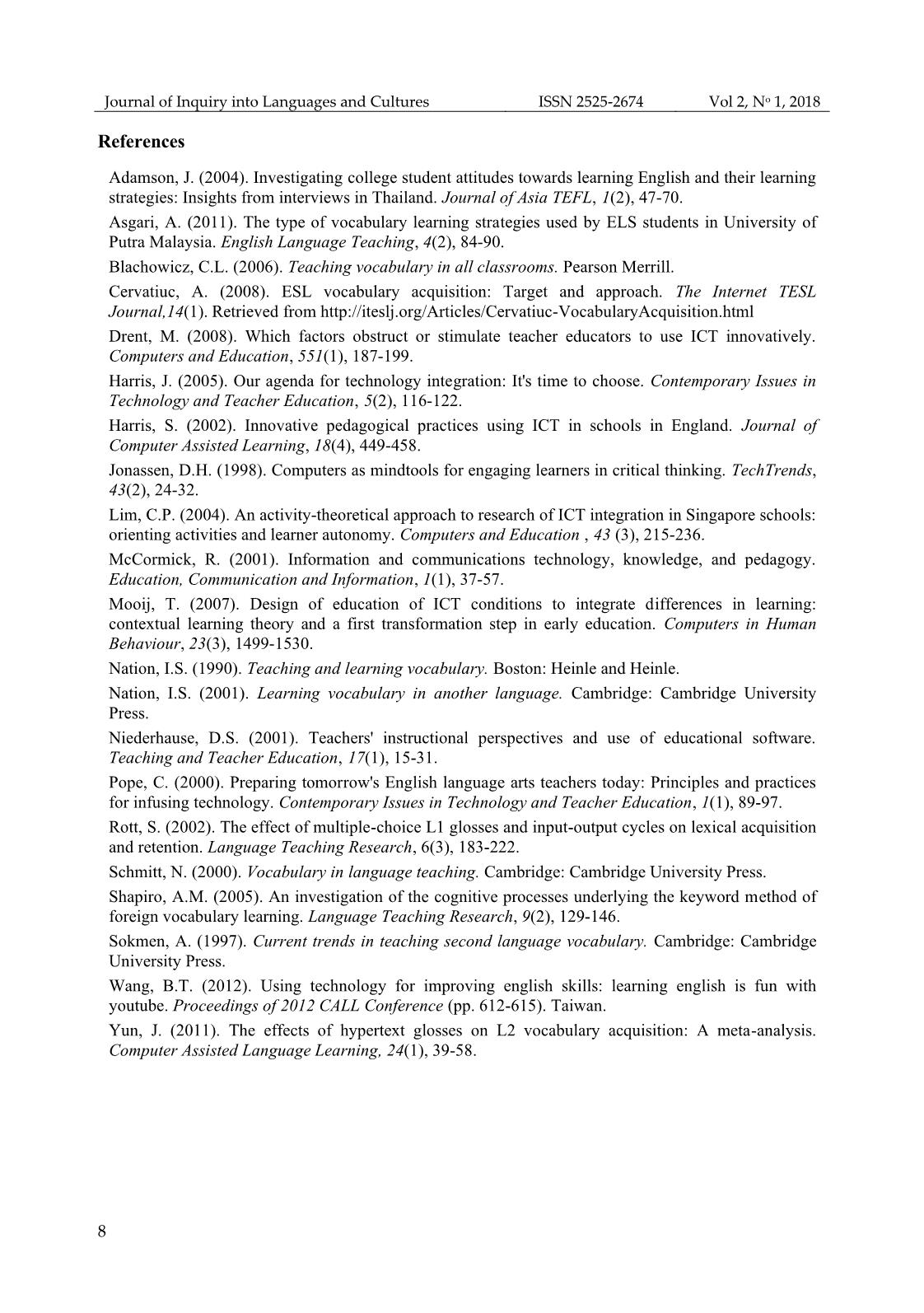
Trang 8
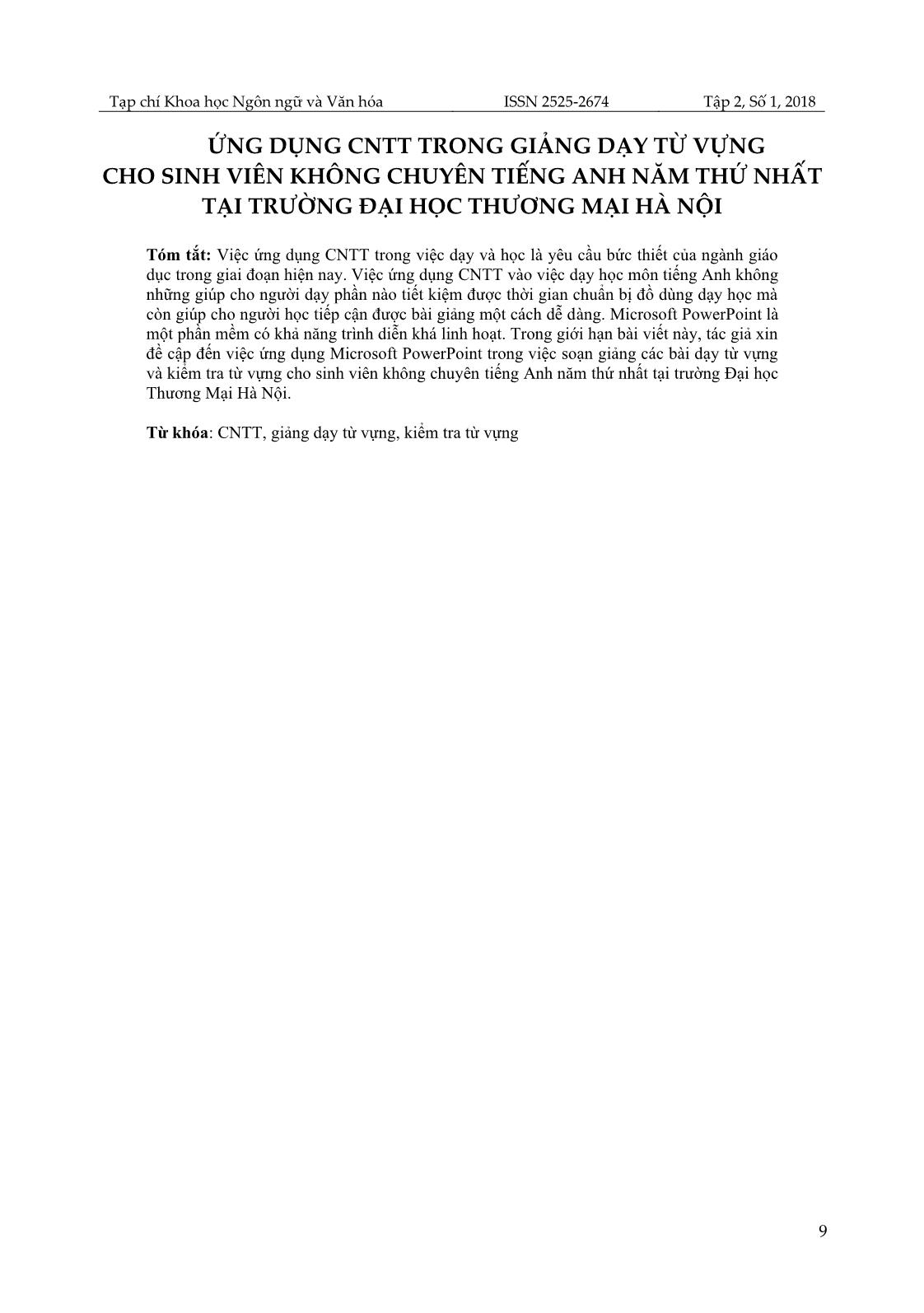
Trang 9
Tóm tắt nội dung tài liệu: Applying information technology in vocabulary teaching and learning for the first-year English non-major students at Thuong Mai University
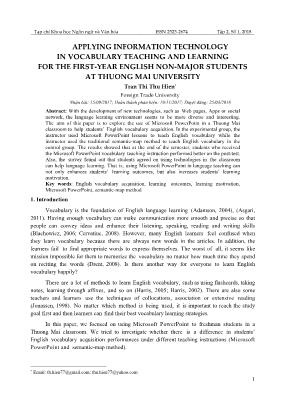
se of Microsoft PowerPoint in the classroom. Q8 In the future, I am willing to try other different technology tools, like Youtube, computer games or Blog, in English language learning. A five-point Likert-scale is used to indicate students’ statement by choosing among the five responses ranging from “strongly disagree to strongly agree”. The data collection was limited to the experimental group (N=36). 3.3. Instrument In order to check whether the two different methods make any difference on students’ English vocabulary acquisition, SPSS 12.0 was used to see if there was a statistically significant difference in two classes’ pre-test and post-test scores. An independent samples t- test was used for comparing the means on variable between two teaching methods. Microsoft PowerPoint was used in the experimental group. This software presented approximately 2000 words and phrases which show the spelling, translation, pronunciation, and image. Besides, descriptive statistics was used to analyze the questionnaire of using Microsoft PowerPoint teaching in the classroom. The frequency percentages, means and SD were reported. 4. Results and discussion 4.1. Students’ Pre-Test Results Based on Table 2, the p value is higher than .05, and this showed that there was no significant difference with experimental group and control group at the beginning of the research. Table 2. The independent sample t-test of English pre-test Number Mean Std Deviation Sig (2-tailed) Experimental group 36 62.12 10.85 .070 Control group 38 60.16 12.79 .070 Tạp chí Khoa học Ngôn ngữ và Văn hóa ISSN 2525-2674 Tập 2, Số 1, 2018 5 4.2. Students’ Post-Test Results According to the results in Table 3, there was a significant difference in the scores between experimental group (M=68.9, SD=6.7) and control group (M=62.0, SD=9.0). That is, the use of Microsoft PowerPoint in English vocabulary teaching has positive effect on students’ performance and helps students in English vocabulary acquisition. Under the Microsoft PowerPoint instruction, the experimental group performed better in the post-test and made a big progress. Table 3. The independent sample t-test of English post-test Number Mean Std Deviation Sig (2-tailed) Experimental group 36 68.9 6.74 .000 Control group 38 62.0 9.08 .000 4.3. Questionnaire Analysis The results of descriptive analysis of the questionnaire (percentages, means and SD) were shown in Table 4. The main purpose of the questionnaire was to understand students’ attitude toward ICT use in the classroom. Moreover, this questionnaire was only distributed in the experimental group. Table 4. Percentages, means and standard deviation of using Microsoft PowerPoint in the classroom Item Percent (%) Mean SD SA A N D SD Q1 42.86 42.86 14.29 0 0 4.29 0.20 Q2 42.31 30.77 23.08 0 3.85 4.08 1.02 Q3 50 46.15 3.85 0 0 4.46 0.58 Q4 57.69 38.46 3.85 0 0 4.54 0.58 Q5 7.69 3.85 34.62 15.38 38.46 4.26 0.70 Q6 46.67 40 13.33 0 0 4.33 0.71 Q7 60 33.33 6.67 0 0 4.53 0.63 Q8 50 43.33 6.67 0 0 4.43 0.63 For question one, 42.86% of the students showed that they liked English better through Microsoft PowerPoint instruction whereas 0% of them denied this statement. Next, for the confidence in English vocabulary learning, there were more than 2/3 of the students stated that they felt more confident whereas only 3.85% of them reported that they were still lack of confidence. Among the 8 questions, question 2 scored the lowest mean of 4.08. It might be the Vietnamese culture because students are shy and humble. Question 3 asked students whether they would spend more time on learning English vocabulary after experienced Microsoft PowerPoint instructions in the classroom. The result of question 3 was very positive because there were 96.15% of the students agreed on this item. The analysis of students’ understanding of English vocabulary showed that they agreed that the use Microsoft PowerPoint was better than the traditional blackboard lecture (mean=4.54). With regard to the only negative item in this questionnaire, question 5 aimed to understand if students’ learning motivation had increased. The results were quite interesting because half of the students disagreed on item 5 whereas 34.62% of the students were neutral and 11.54% of them Journal of Inquiry into Languages and Cultures ISSN 2525-2674 Vol 2, No 1, 2018 6 agreed on this item. Question 6 wanted to test students’ self-study attitude by asking if they would download the software and reviewed the lessons. The results showed that 86.67% of the students would do this after class whereas 13.33% of them were neutral. Question 7 aimed to know the overall attitude among students toward the use of iPad teaching in the classroom, and the result scored the highest “strongly agree” of all the 8 items. That is, about 93.33% of the students had high evaluation on the use of Microsoft PowerPoint in the classroom. The final question wanted to know if students wanted to try other ICT tools in the future. The results turned out to be good due to nobody disagreed on this item and approximately 93.33% of the students wanted to continue to use the ICT tools in the future. 4.4. Discussion The findings of this paper are summarized as follows: (1) The Microsoft PowerPoint created significant progress in students’ English vocabulary acquisition. The current research tended to understand students’ progress and attitude in English vocabulary acquisition under the Microsoft PowerPoint teaching. The findings in this paper showed very positive results. First of all, the experimental group, who learned English vocabulary through the Microsoft PowerPoint instruction, performed better in the English post-test than the control group. Table III showed that the final exam average score of the experimental group (M=68.9) was higher than that of the control group (M=62). The independent sample t-test showed that there was a significant difference between the experimental group and the control group (p=.000<.05). This also proved that the proposed teaching method (using Microsoft PowerPoint in the classroom) is effective. (2) Using ICT teaching in the classroom had positive effects on students’ English learning motivation. Another major finding in this paper was that students’ learning motivation was increased in the ICT classroom. The research explored students’ attitude toward the use of ICT in the classroom. According to items 3, 5 and 6 in the questionnaire, students were more active for English vocabulary learning. Moreover, based on item 1 and item 2, students’ attitude toward English was changed, and there were more students who wanted to learn English. (3) The use of Microsoft PowerPoint teaching created a relaxed learning environment. In English vocabulary teaching, the effectiveness of vocabulary acquisition depends on the method the teacher uses and teacher’s enthusiasm (Yun, 2011). Since the development of English vocabulary acquisition is a long-term work, the learning should not be limited to in-class lectures. Instead, teachers should encourage students to develop self-study habits and increase students’ learning motivation. By using the ICT, students will feel familiar and relaxed in the classroom. In this paper, the use of Microsoft PowerPoint in English vocabulary teaching provided lots of pictures, words, sentences, audio-files and pronunciation practices in the traditional classroom. It was totally different from the traditional teacher- centered lecture. With the use of Microsoft PowerPoint, there were more interactions between the teacher and students, and students seemed to be more focused during the lectures. Tạp chí Khoa học Ngôn ngữ và Văn hóa ISSN 2525-2674 Tập 2, Số 1, 2018 7 According to the research, the visual effects provided by the ICT really help the increase in students’ learning motivation (Mooij, 2007), (Nation, Learning Vocabulary in Another Language, 2001). The results of this paper were corresponded with these previous researches. Hence, the Microsoft PowerPoint provided a meaningful learning interface in the traditional Vietnamese classroom. Instead of memorizing the word by word, students got more chances to think and apply the words. Also, the learning responsibility has been transferred from teacher to students. Moreover, students can download the software after class and review the lessons at any time, any place. It is like seamless learning and if the teacher can use this kind of ICT tools in the classroom, it can be beneficial for both teachers and students. (4) The ICT teaching had influenced students’ willingness of using computers in English learning. Based on the results of the questionnaire, students wanted to try different ICT in future study. After the instructor used the Microsoft PowerPoint to teach English vocabulary in the classroom, students seemed to understand how to apply the ICT in learning and this is in line with the previous research findings (Rott, 2002; Schmitt, 2000). 5. Conclusion and Implications According to the research results, the instructor believes that using Microsoft PowerPoint in English teaching has positive effect on students and the results were as follows: (1) The effectiveness of using Microsoft PowerPoint in students’ English vocabulary acquisition had been approved. After using Microsoft PowerPoint in English vocabulary teaching, the experimental group showed a great performance on the post-test than the control group. Hence, it is believed that applying ICT method in English teaching has its positive effectiveness. (2) Students’ attitude toward ICT in the classroom was positive. According to the results of the questionnaire, the experimental group felt motivated, delighted and interested in using Microsoft PowerPoint to learn English vocabulary. (3) The teachers are encouraged to use more ICT applications in the classroom in the future. Based on item 10 in the questionnaire, students are willing to learn English by using different ICTs. Therefore, teachers need to realize this trend and apply more ICTs in English language teaching in the future not only to meet students’ needs, but also to create a lively learning environment. However, the number of students in this paper limits the reliability of the results. If there are more classes and students involving in this research, and teachers’ attitude can also be investigated, the reliability and validity of this paper can be increased. In the future, it is also suggested to include interviews of teachers and students to enhance the completeness of the research. Journal of Inquiry into Languages and Cultures ISSN 2525-2674 Vol 2, No 1, 2018 8 References Adamson, J. (2004). Investigating college student attitudes towards learning English and their learning strategies: Insights from interviews in Thailand. Journal of Asia TEFL, 1(2), 47-70. Asgari, A. (2011). The type of vocabulary learning strategies used by ELS students in University of Putra Malaysia. English Language Teaching, 4(2), 84-90. Blachowicz, C.L. (2006). Teaching vocabulary in all classrooms. Pearson Merrill. Cervatiuc, A. (2008). ESL vocabulary acquisition: Target and approach. The Internet TESL Journal,14(1). Retrieved from Drent, M. (2008). Which factors obstruct or stimulate teacher educators to use ICT innovatively. Computers and Education, 551(1), 187-199. Harris, J. (2005). Our agenda for technology integration: It's time to choose. Contemporary Issues in Technology and Teacher Education, 5(2), 116-122. Harris, S. (2002). Innovative pedagogical practices using ICT in schools in England. Journal of Computer Assisted Learning, 18(4), 449-458. Jonassen, D.H. (1998). Computers as mindtools for engaging learners in critical thinking. TechTrends, 43(2), 24-32. Lim, C.P. (2004). An activity-theoretical approach to research of ICT integration in Singapore schools: orienting activities and learner autonomy. Computers and Education , 43 (3), 215-236. McCormick, R. (2001). Information and communications technology, knowledge, and pedagogy. Education, Communication and Information, 1(1), 37-57. Mooij, T. (2007). Design of education of ICT conditions to integrate differences in learning: contextual learning theory and a first transformation step in early education. Computers in Human Behaviour, 23(3), 1499-1530. Nation, I.S. (1990). Teaching and learning vocabulary. Boston: Heinle and Heinle. Nation, I.S. (2001). Learning vocabulary in another language. Cambridge: Cambridge University Press. Niederhause, D.S. (2001). Teachers' instructional perspectives and use of educational software. Teaching and Teacher Education, 17(1), 15-31. Pope, C. (2000). Preparing tomorrow's English language arts teachers today: Principles and practices for infusing technology. Contemporary Issues in Technology and Teacher Education, 1(1), 89-97. Rott, S. (2002). The effect of multiple-choice L1 glosses and input-output cycles on lexical acquisition and retention. Language Teaching Research, 6(3), 183-222. Schmitt, N. (2000). Vocabulary in language teaching. Cambridge: Cambridge University Press. Shapiro, A.M. (2005). An investigation of the cognitive processes underlying the keyword method of foreign vocabulary learning. Language Teaching Research, 9(2), 129-146. Sokmen, A. (1997). Current trends in teaching second language vocabulary. Cambridge: Cambridge University Press. Wang, B.T. (2012). Using technology for improving english skills: learning english is fun with youtube. Proceedings of 2012 CALL Conference (pp. 612-615). Taiwan. Yun, J. (2011). The effects of hypertext glosses on L2 vocabulary acquisition: A meta-analysis. Computer Assisted Language Learning, 24(1), 39-58. Tạp chí Khoa học Ngôn ngữ và Văn hóa ISSN 2525-2674 Tập 2, Số 1, 2018 9 ỨNG DỤNG CNTT TRONG GIẢNG DẠY TỪ VỰNG CHO SINH VIÊN KHÔNG CHUYÊN TIẾNG ANH NĂM THỨ NHẤT TẠI TRƯỜNG ĐẠI HỌC THƯƠNG MẠI HÀ NỘI Tóm tắt: Việc ứng dụng CNTT trong việc dạy và học là yêu cầu bức thiết của ngành giáo dục trong giai đoạn hiện nay. Việc ứng dụng CNTT vào việc dạy học môn tiếng Anh không những giúp cho người dạy phần nào tiết kiệm được thời gian chuẩn bị đồ dùng dạy học mà còn giúp cho người học tiếp cận được bài giảng một cách dễ dàng. Microsoft PowerPoint là một phần mềm có khả năng trình diễn khá linh hoạt. Trong giới hạn bài viết này, tác giả xin đề cập đến việc ứng dụng Microsoft PowerPoint trong việc soạn giảng các bài dạy từ vựng và kiểm tra từ vựng cho sinh viên không chuyên tiếng Anh năm thứ nhất tại trường Đại học Thương Mại Hà Nội. Từ khóa: CNTT, giảng dạy từ vựng, kiểm tra từ vựng
File đính kèm:
 applying_information_technology_in_vocabulary_teaching_and_l.pdf
applying_information_technology_in_vocabulary_teaching_and_l.pdf

